Heat-related issues are a leading cause of DNF in endurance races. A rise in your core temperature during exercise can cause a cascade of physiological effects, which increase the relative intensity of exercise and limit your performance.
To help you stay cool, I’ve taken a look at the cooling strategies you can use before and during exercise to maintain your performance…
How cooling strategies help you perform
When you get hot, blood flow is redirected from your muscles to the skin to facilitate heat transfer through the evaporation of sweat, which is your body's most effective method of cooling. It’s a necessary process but it reduces the blood flow to your working muscles during exercise, which in turn reduces your aerobic capacity.
For context, when body temperature reaches ~39.5ºC, a well-trained athlete who isn’t acclimated to the heat can expect a ~20% reduction in V̇O₂max,. This leads to an increased rate of carbohydrate oxidation, faster onset of fatigue and ultimately, impaired endurance performance.
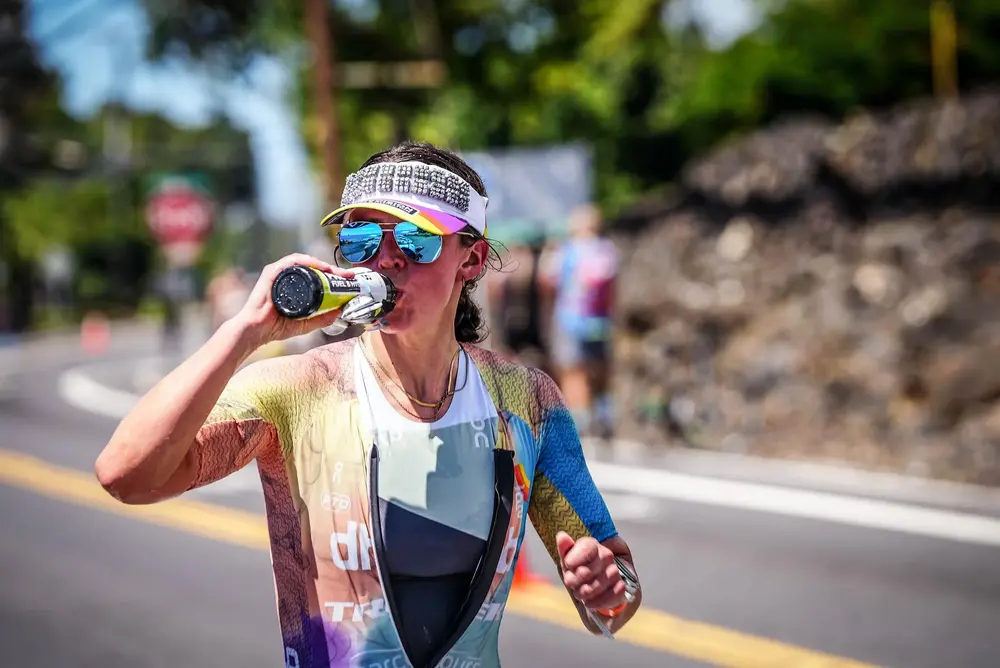
As you warm up, you may experience a phenomenon known as cardiovascular drift - as more and more blood is redirected away from the working muscles, your heart rate increases for the same level of effort. This phenomenon can be caused by exercising for longer than you’re recently familiar with, dehydration, and heat stress.
Even well-trained athletes who’ve undergone a period of heat training to prepare for a hot race will experience a decline in performance with increases in body temperatures, especially when racing in hot and/or humid conditions.
Encouragingly, scientific research has shown that cooling before and/or during hot events can help increase your ‘thermal comfort’ and keep you cool.
Across 28 studies that looked at various cooling strategies, athletes’ performance improved by ~6.7% overall:
- Pre-cooling before exercise resulted in a ~5.7% performance increase
- Cooling mid-event resulted in a ~9.9% performance increase
Systematic reviews support the idea that cooling strategies provide performance gains during endurance exercise. But, when working out which cooling strategy is right for you, it’s a challenge to ignore the obvious fact that you’re being cooled by whichever method you use.
So, even if some of the performance benefit comes from the placebo effect of feeling cooler, if we think that a cooling strategy is helping us perform, then it probably is!
Start cool: Pre-cooling strategies
Pre-cooling before exercise is broadly beneficial, especially for shorter self-paced (<60 minutes) or fixed-intensity exercise, and in hot/humid environments where it's difficult to stay cool when you're warming up before competition.
We often see Tour de France riders wearing ice vests or sitting in front of large fans when warming up for stages in hot conditions. They’re attempting to limit the rise in their body temperature in challenging start-line conditions.
80% of marathon runners at the 2019 World Athletics Championships planned to use pre-cooling strategies prior to their races, with 53% opting to use ice vests...
Cooling vests
Commonly used at hot start lines (e.g. Formula 1, Tour de France), cooling vests help to limit heat storage before the gun goes off.
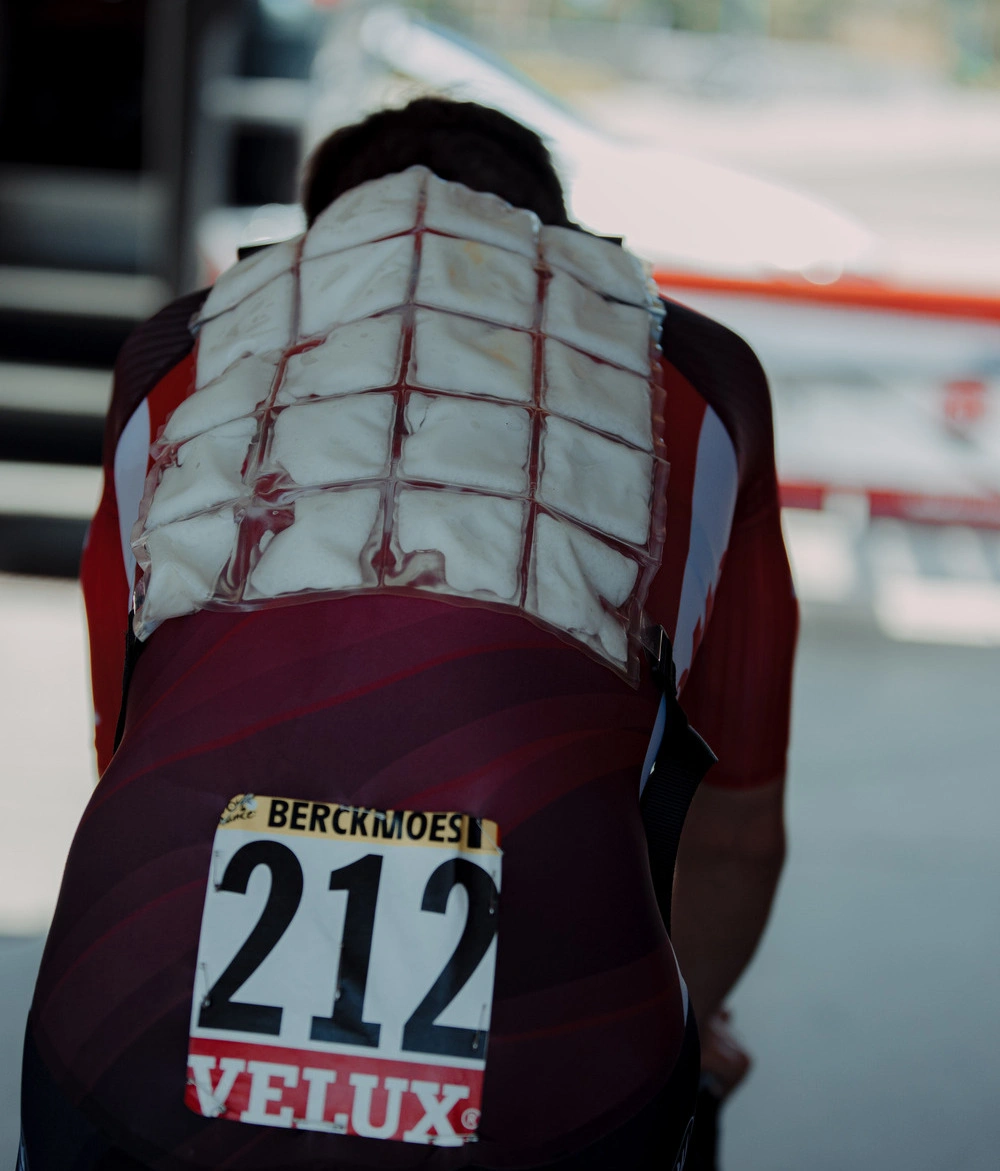
The vests are initially quite effective at cooling when large temperature gradients exist between the skin (~35ºC) and the ice vest (~0ºC). But, as the vest warms up and the skin cools down, this temperature gradient all but disappears, and the vest can progress from helping to hindering. It can lead to increased heat storage through impeded evaporation, so the vest needs to be replaced frequently with a fresh one.
Therefore, vests as a pre-cooling method tend to test as less effective than cold water immersion or ice slushies, but can be a practical choice despite the logistical constraints (i.e. need to be kept in the freezer) and relatively significant costs.
Cold-water immersion
Cold-water immersion works primarily through conduction, lowering both skin and core temperature before exercise begins. This creates a greater “heat sink” capacity (i.e. more 'room' before you reach critical body temperatures (~39.5°C) where performance typically declines). Studies show that pre-cooling with cold water immersion can improve time-trial performance in hot conditions by delaying the rise in core body temperature and reducing cardiovascular strain.
It’s effective for shorter events where early pacing is critical (e.g. short running races and cycling time trials), but relatively impractical for most.
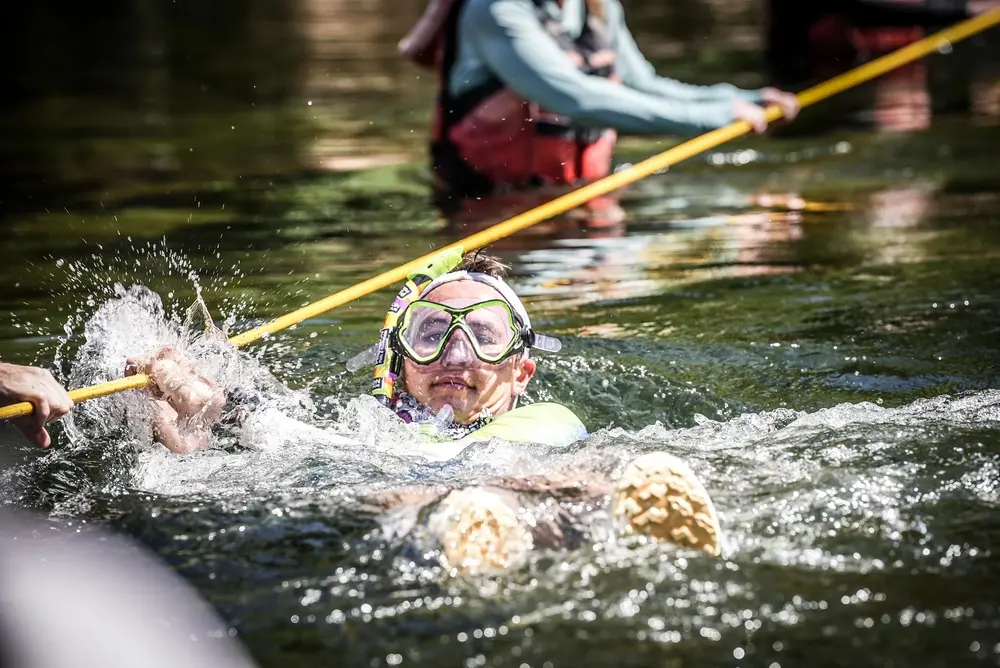
Ice slushies
Consuming ice slushies before your event is another useful tactic. Not only can it be a source of useful water and electrolytes, but the ice also helps to lower your core body temperature from the 'inside out', primarily through the phase change of the frozen semi-solid ice crystals, which liberate heat as they change into a liquid.
Athletes who ingested ice slushies before running and cycling in the heat extended their time to exhaustion and reported improved thermal comfort. While this can sometimes lead to higher finishing core temperatures (because athletes are able to push harder), the net effect is usually improved endurance capacity without an increased risk of exertional heat illness.
Studies indicate that drinking ice slushies before endurance events helps to combat thermal strain during exercise. Crucially, to have the intended effect, ice slushies must be consumed as ice and not melted in your mouth before swallowing.
Pre-Cooling Takeaways
According to research, athletes who use cold water immersion and ice slushies pre-exercise start with lower body temperatures. This reduces the time they spend at high body temperatures during events and therefore reduces the subsequent stress caused by being hot. The same research also points to pre-cooling strategies possibly reducing the risk of experiencing heat-related issues during endurance events, despite sometimes finishing at even higher body temperatures.
Pre-cooling works, but use these techniques with caution when preparing for events beyond ~40 minutes - pre-cooling strategies may negatively affect your pacing strategy (i.e. you may feel great initially from the pre-cooling, go out too fast and subsequently accumulate too much fatigue and perform worse than without pre-cooling).
Stay cool: Cooling strategies
Since there are many methods for cooling during exercise, not all will be applicable to your sport. It’s important to consider these strategies in relation to what’s most practical for your event.
I’ve left cold water immersion out of this section as it isn’t possible during most endurance events, although we did see Jeff Mogavero use this technique when running the fastest ever debut time at Western States 100 in 2025!
Ice bandanas
Wearing ice bandanas, ice towels or stuffing your pack with some ice can provide immediate perceptual and actual body temperature cooling.
A study published in The Journal of Science and Medicine in Sport examined the effects of various cooling strategies during simulated Australian Open tennis matches. The application of ice towels was found to limit the rise in core temperature by 0.7ºC (from 38.8 to 38.1ºC on average) and also reduced heart rate, whilst improving perceived exertion.
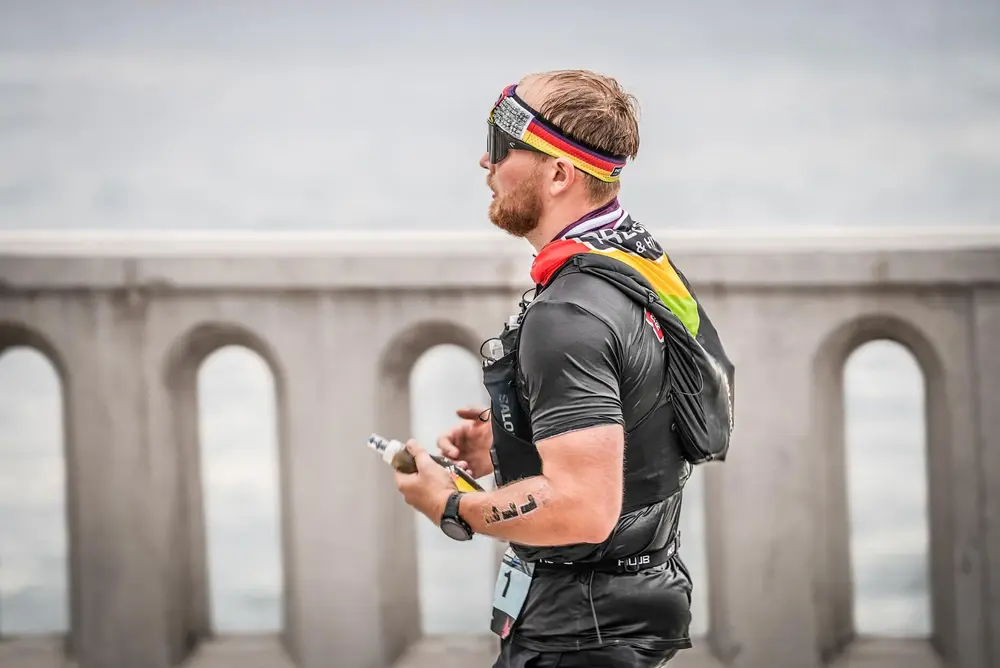
But, the study authors noted that towels might present a barrier to sweat evaporation and could cause local vasoconstriction, which may limit overall cooling effectiveness. Despite those potential drawbacks, physiological responses were much improved with ice towels.
You can use ice stations at races or carry your own ice packs from crews in a hydration vest. Critically, only use a type of ice towel, bandana, or pack which allows the melting ice to evaporate off your skin; otherwise, you're leaving plenty of heat on the table. Ice towels and bandanas cool through conduction first, then continue cooling as the melted water evaporates.
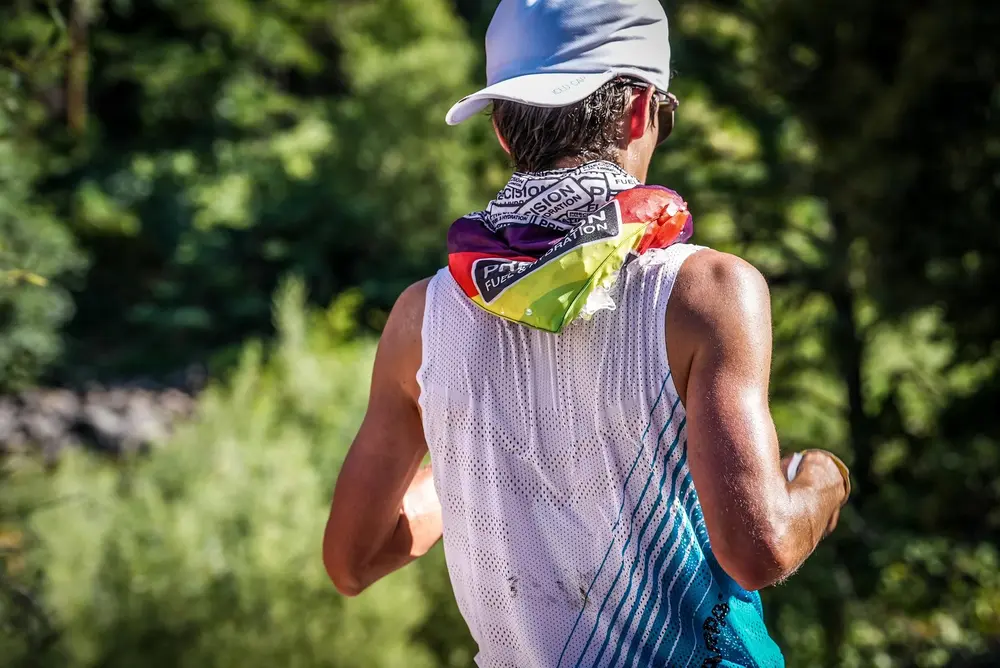
Skin wetting/dousing
Dousing yourself with water has been shown to improve 10km running performance in ~30ºC and 47% relative humidity). For most events, this is one of the most practical mid-race cooling strategies given the availability of cups at aid stations.
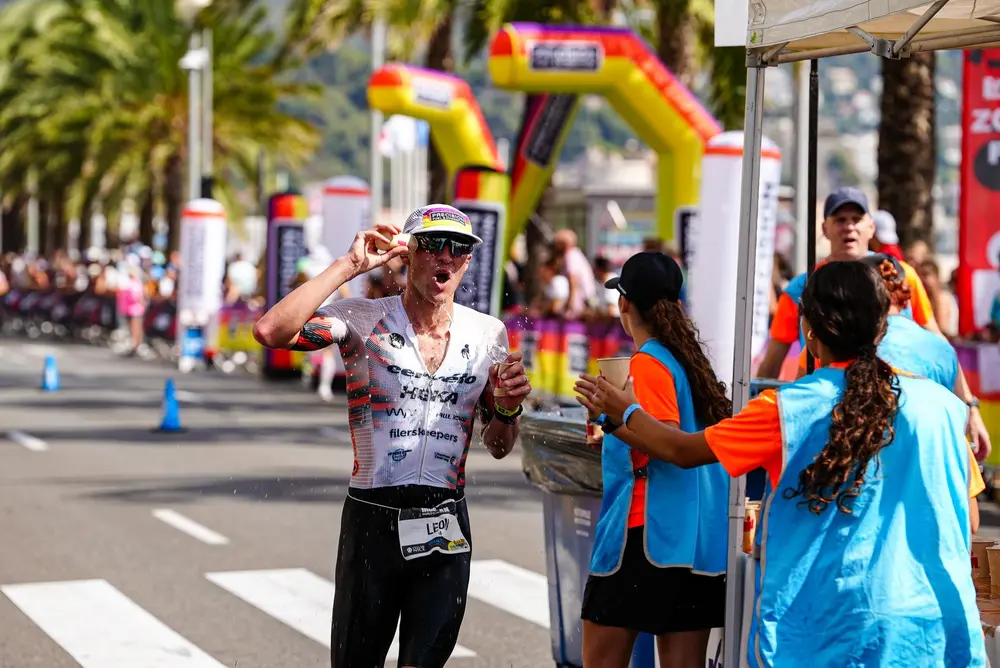
Water dousing also reduces sweat rate by replacing a proportion of your sweat, which reduces how much you need to drink and reduces total fluid loss thereby reducing total fluid turnover. It’s particularly useful during very hot and dry events, where your maximum capacity for sweat loss can limit performance.
Chris Myers, who finished 2nd at Western States in 2025, told us:
I spent very little of the second half of Western States dry. I used larger-than-normal ice chunks in my pack, which took around 90 minutes to fully melt. I kept my arm sleeves filled with ice, and soaked them at every aid station, all of which kept me cool and wet.
Ice slushies and cold fluids
Ingesting both ice slushies (<~-2ºC) or cold fluids (~4ºC) during exercise tend to show benefits for performance. Research suggests that drinking chilled beverages can help reduce core temperature and prevent excessive dehydration during prolonged exercise.
They reliably improve thermal comfort and perceived exertion, but their effect on core temperature is inconsistent. Some studies show no reduction or even slightly higher temperatures at the end of exercise, likely due to suppressed sweat rates. They may therefore be more effective in humid environments, where sweat evaporation is already limited, rather than in hot-dry climates where high sweat rates are essential.
At ultra races in hot environments, many athletes have well-stocked crews that resupply athletes with ice-cold drinks at crewed aid stations. But bear in mind that accessing ice slushies and consistently cold beverages may not always be feasible at all events.
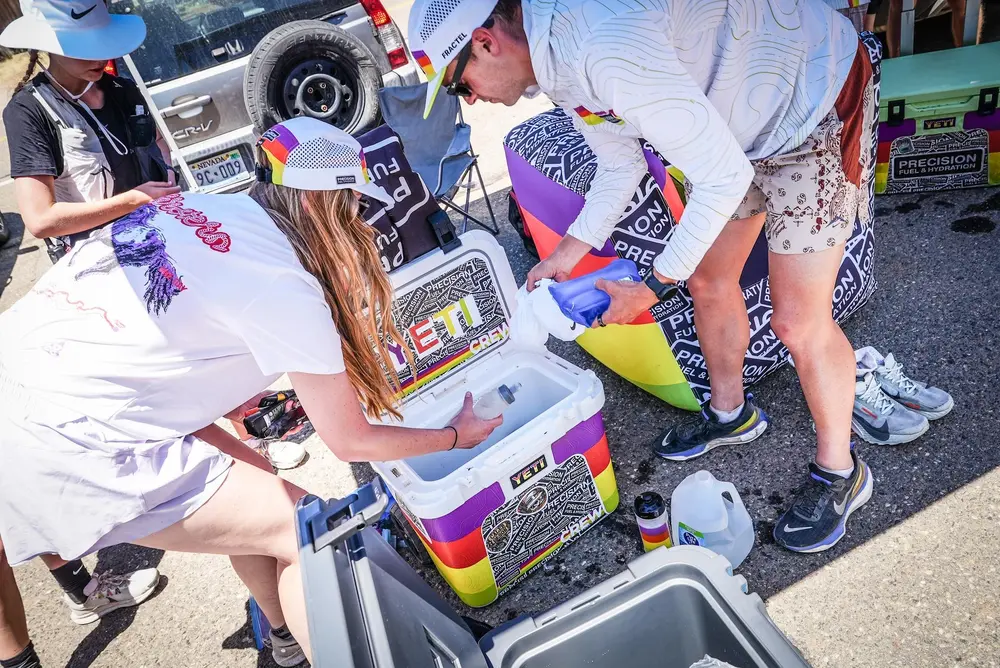
Palm/hand cooling
Palm cooling has been touted by some as a technology that can “directly cool your muscles”.
The idea is that the hands are the most effective location for heat transfer sites since they’re highly vascularised by deeper blood vessels rather than tiny capillaries like many other sites. Normally, ice or cold objects close to 0ºC constrict blood vessels leading to reduced heat exchange, but certain expensive devices are said to be able to circumvent this problem by circulating cold (but not too cold) water across the palms of the hands.
What does the evidence say? So far, there has been one study in an endurance setting published, which also happens to be published by the founder of the device.
In the paper, they observed lower core temperature and heart rate responses with the device compared to control while walking on a treadmill. This finding has not been replicated in any subsequent endurance-based research; this is despite 20 years of continued research in the field of cooling strategies, and research into palm cooling with similar but alternate technologies has fallen flat when explored in relation to endurance exercise and heat stress.
Given the costs, lack of quality evidence and practical constraints of using palm cooling devices during exercise, consider them a low-priority.
Cooling Strategy Takeaways
Ice towels, bandanas and water dousing appear to have the least drawbacks for athletes, and are relatively easy to apply. There’s just the logistical constraints of keeping the ice cool and getting access to them mid-race to consider.
Strategies that use ice provide cooling predominantly through the phase change from a solid to a liquid as the ice melts. It directly cools the skin surface through conduction and then evaporation as the ice melts from the ice towel or bandana and evaporates off the surface of the skin.
Ice slushies provide the additional benefit of fuel and hydration (if mixed with carbs and electrolytes). They can make you feel cooler, yet don’t consistently reduce core temperature during exercise because sweating may disproportionately drop. This is especially true in hot, dry environments where maximum sweat rates are essential for keeping your body temperature in check. With that said, you should still receive performance and perceptual benefits with consuming ice slushies in the heat. Just use them more cautiously in very hot and dry environments.
Ultimately, water dousing is one of the simplest and most practical mid-race cooling strategies. By lowering skin temperature and reducing sweat requirements, it helps keep you cool, conserve fluids, and improve comfort and performance, especially in hot, humid races where aid station water is readily available.
Perhaps counterintuitively, the most effective time to use any cooling strategy is at the start of exercise, or when a change of conditions can augment the rate of heat storage. For example, when going from bike to run during a triathlon - as you slow down getting off the bike, you lose the benefit of the high convective cooling from the fast moving air, which usually means you need to sweat more to keep cool. If we apply cooling strategies specifically during this time, we can artificially offload more heat and store less heat, which is the ultimate goal. It’s always harder to lose stored heat once we have it, than not store it in the first place!
The future of cooling
Looking ahead to new developments in cooling technology, strategies that focus on the following principles are the most promising:
- Sustained efficient cooling through the evaporation of fluids such as refillable ice bandanas, which cool at first via conduction from the ice to skin and then via the evaporation of the melted ice
- Improvements in textile design which may be designed with water retention and sweating efficiency in mind - like the Nike All Conditions Gear trail running shirt we saw Caleb Olsen wearing en route to winning WSER in 2025.
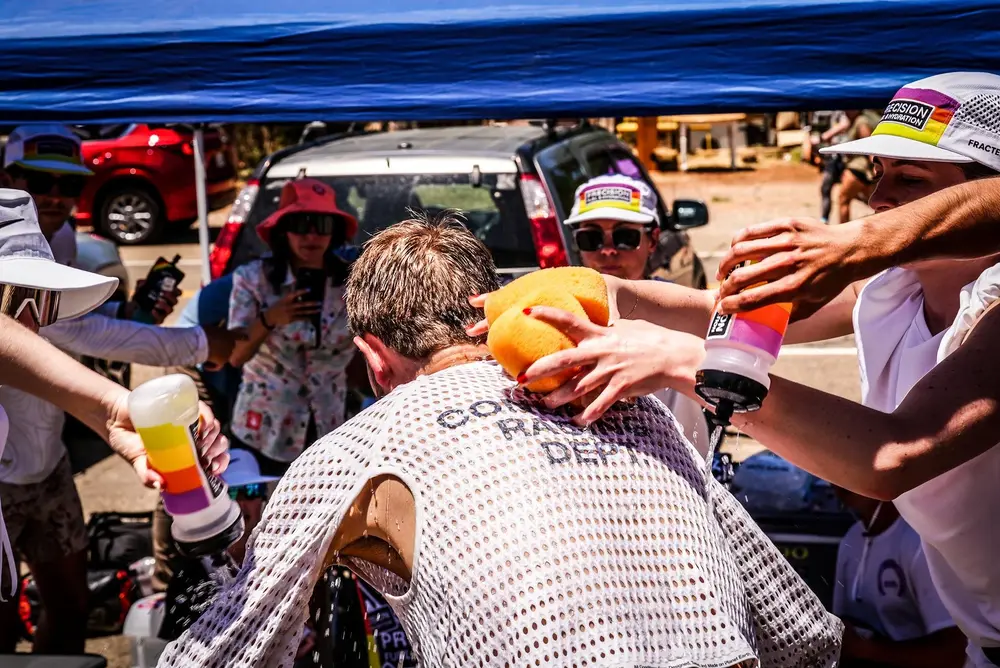
Key takeaways
1. Trial and error: Not all cooling strategies will work for every athlete. It’s important to test different cooling techniques during your training to find out which works best for you.
For example, cold water immersion might not be comfortable nor practical for everyone, so consider alternatives like ice bandanas which can often be refilled regularly at aid stations.
2. Hydration is key: Topical cooling doesn’t work without proper hydration. If we let ourselves get too dehydrated, our sweat rate drops to conserve fluid and that results in our thermoregulation being compromised.
As our sweat rate is progressively lowered, our thermal limits of heat balance are lowered alongside them and this results in increased heat storage.
Ensure that you’re drinking enough electrolytes before, during, and after your race.
3. Avoid overcooling: While cooling strategies are important, overcooling can also be dangerous. Be mindful not to cool your body temperature too much, as it can lead to hypothermia. Be sure to monitor your body’s reaction during training and adjust strategies accordingly.
Final summary:
- Staying cool in hot conditions is crucial for endurance athletes looking to perform at their best while staying safe
- Using cooling strategies before and during exercise can significantly improve performance and reduce the risk of heat-related issues
- Experiment with cooling strategies to find what works for you, especially in training (never underestimate the power of a fan during indoor training and simply dousing water on your skin)
- Be sure to test different methods in conditions similar to your race to ensure you're prepared for your next event
- Ultimately, any cooling strategy, like your fuel and hydration strategy, needs to be personalised to your individual physiological and race needs
